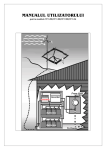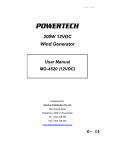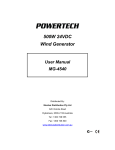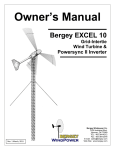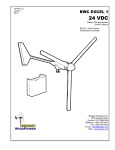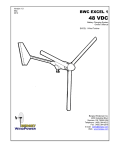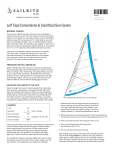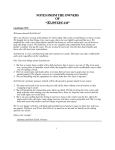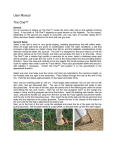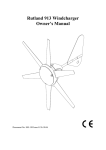Download Installation and Operating Instructions for the Navitron
Transcript
MG4520 Wind Generator Owners Manual BEFORE YOU BEGIN: Read this entire manual. Following the instructions and recommendation in this manual will help assure safe and enjoyable use of your new renewable energy system. SAFETY INFORMATION: these systems present mechanical, electrical and chemical(battery) hazards that can be life threatening. The tower or support structure could fall and cause injury or death and property destruction. A component of the wind generator could come loose causing injury or death. High voltage from the wind generator or the inverter can cause injury or electrocution. A burn injury can result from an electrical short. A severe chemical burn including blinding can occur from a battery explosion or contact with the sulphuric acid in a lead-acid battery. These conditions are addressed in the following safety messages: STOP! DANGER! It is your responsibility to obtain all required permits and engineering certifications for your tower and tower location. Soil and wind conditions vary and tower foundations must be designed for your specific location. Tower must not be able to fall on occupied buildings, neighbour’s property or power lines. Tower climbing is dangerous and should be attempted only by experienced personnel using proper safety equipment. Locate your mounting mast(tower) well away from occupied buildings and power lines: a minimum of 100m is recommended. STOP! DANGER! If the generator appears or sounds loose in the tower or is making an unusual sound, the condition must be corrected immediately. A loose generator or component will soon damage itself further and may fall from the tower or lose parts that could be lethal. Never stand in line with an operating propeller. STOP! DANGER! Provide climbing protection against all unauthorized persons or children. Never allow an untrained person or someone without the proper safety equipment to climb the tower. Always stop the propeller before climbing the tower. Both falling from the tower and contact with the operating propeller can be lethal. STOP! DANGER! High voltage systems(system with ainverter) represent a dangerous shock hazard and could be lethal. All high voltage systems should be wired and maintained by a qualified and licensed electrician. STOP! DANGER! Batteries may emit explosive and irritating gas while charging. Never turn on a light switch or make any other electrical connection or light a match or make any type of spark near a recently-charged battery. Use protective gloves and eyeglasses when working around a battery. Turn off all loads, wear safety glasses, and look away when making a final battery connection. STOP! DANGER! Never put objects on top or near the charge controller, inverter, aurora wind interface, when applicable. These devices must dissipate heat as part of normal operation. FIRE AND FAILURE can result if airflow is blocked. Disclaimer Unless specifically agreed to in writing, we (a) Makes no warranty as to the accuracy, sufficiency or suitability of any technical or other information provided in this manual or other documentation. (b) Assumes no responsibility or liability for loss or damage, whether direct, indirect, consequential or incidental, which might arise out of the use of such information. The use of any such information will be entirely at the USER’S risk. 1. Overview The FD200W wind turbine generator system is a state of –the-art small generator designed to charge batteries and supply electrical loads in a 12V or 24V power system. When used in conjunction with a suitable sine wave DC-AC inverter and a battery bank, the FD200W can also be connected to the power grid. The FD200W features superior low-wind-speed performance, very high system efficiency, and low noise. Charge Controller - + fuse - + Battery Bank What you should have with MG4520: 1 Tail fin 1 tail boom 3 aerofoil blades 1 large alternator connected to a length of cable 1 hub 1 nose cone 1 charge controller 2. System Description The major components of the MG4520 wind generator are shown as below. Components of a wind energy system. Blades/Rotor System The rotor system consists of three aluminium blades. Acting like aircraft wings, the blades convert the energy of the wind into rotational forces that can drive a generator. The aluminium blades are exceptionally strong . The rotor has three blades because three blades will run much smoother than rotors with two blades. A. Alternator The MG4520 wind generator is a horizontal axis wind generator. The alternator utilizes permanent magnets and has an inverted configuration in that the outside housing(magnet can) rotates, while the internal windings and central shaft are stationary. The output from the alternator is three-phase alternating current(ac), but it is rectified to direct current by the charge controller which is a part of the system. Since it uses permanent magnets, the alternator is generating voltage whenever the rotor is turning. B. Nacelle The nacelle is the aluminium housing around the main body of the machine. It contains the main structural backbone of the turbine(called the mainframe), the yaw bearings, and the tower mount. The yaw bearings allow the wind turbine to freely pivot around the tope of the tower so that the rotor will face into the wind. C. Tail Assembly and AutoFurl Operation The tail assembly, composed of a tail boom and the tail fin, keeps the rotor aligned into the wind at wind speeds below approximately 12 m/s. At about 12 m/s the AutoFurl action turns the rotor away from the wind to limit its speed. The tail appears to fold, but in reality the tail stays stationary, as the rotor turns sideways to the wind. The rotor does not, however, furl completely sideways. This allows the turbine to continue to produce power in high winds. When the high winds subside the AutoFurl system automatically restores the turbine to the normal straight position. D. Charge Controller The charge controller serves as the central connection point for the electrical components in the system and it provides 2 valuable control functions. It rectifies the AC output from the turbine into direct current(DC) and charge the battery. 1) Turn the switch to “auto” position”. The controller continually monitors the battery voltage and compares it to the regulation set point. The regulation set point is factory set to 15.1V(12V Turbine) or 30.2V(24V Turbine). When the battery voltage rises above the set point, it automatically stops charging the battery. It will wait for the battery voltage to drop. Normal charging will resume when the battery voltage drops slightly below the fully charge level. For 12 V turbine the controller will resume charging at 11V(22V for 24V turbine). 2) In case that the controller’s auto monitoring function fails, turn the switch to “hand” position, the controller will charge the battery. When the battery voltage rises above the set point, disconnect the battery by hand. E. Battery Bank Size We recommend one piece of 12V/200Ah normal lead-acid battery for 200W/12V system or two pieces of 12V/200Ah batteries for 200W/24V system. 2. System Operation A. Normal Operation The rotor of the MG4520 should begin to rotate when the wind speed reaches approximately 3m/s. (for the first several weeks of operation, however, the start-up wind speed will be higher because the bearing seals have not worn in) battery charging should commence shortly after the rotor spins up to speed. Once turning, the rotor will continue to turn in lower wind speeds, down to approximately 2.5m/s. the rotor speed will increase with increasing wind speed and the system will provide a higher output. This output increase rapidly because the energy available in the wind varies as the third power(cube) of the wind speed. For example, if the wind speed doubles from 5m/s to 10m/s, the energy in the wind increases by a factor of eight(23=2x2x2=8). One result of this relationship is that there is very little energy available in light winds. For the average site, winds in the range of 5.5-12m/s will provide most of the system annual energy production. B. High Winds – AutoFurl During periods of high wind speeds the AutoFurl system will automatically protect the wind turbine. When furled, the power output of the turbine will be significantly reduced. In winds between 13m/s and 18m/s it is normal for the turbine to repeatedly furl, unfurl and then furl again. In winds above 18m/s the turbine should remain continuously furled. AutoFurl is a simple and elegant method of providing high wind speed protection. The AutoFurl system is based on aerodynamic forces on the rotor, gravity, and the carefully engineered geometry of the wind turbine. As shown in Figure, the aerodynamic forces acting on the blades cause a thrust force pushing back on the rotor. This force increases with increasing wind speeds. The thrust force acts through the centreline of the rotor, which is offset from the centreline of the tower pivot axis(yaw axis). Therefore, the thrust force on the rotor is always trying to push the rotor over to the side, away from the wind. But the rotor is kept facing into the wind at speeds up to ~12.5m/s by the wind turbine tail assembly. The tail, in turn, is kept straight by its own weight because its pivot at the back of the nacelle is inclined. So the weight of the tail holds it against a rubber bumper and the tail holds the rotor into the wind. The geometries in the systems are carefully balanced so that at ~12.5m/s the rotor force acting on the yaw-offset is large enough to overcome the preset force holding the tail straight. At this point the rotor will start turning away from the wind or furling. The tail stays aligned with the wind direction. The speed of furling depends on the severity of the wind gusts and whether the wind turbine stays furled depends on the wind speed. As the wind turbine furls the geometry of the tail pivot caused the tail to lift slightly. When the high winds subside the weight of the tail assembly returns the whole turbine to the straight position. The AutoFurl system works whether the turbine is loaded or unloaded. The AutoFurl system is completely passive, so it is very reliable and since there are no wear points, like in a mechanical brake system, it is very robust. There is one situation in the field, however, that we have found can disrupt the operation of AutoFurl. If the wind turbine is installed on a sharp hill or next to a cliff so that the wind can come up through the rotor on an incline(e.g., from below; as opposed to horizontally) we know that this will affect furling and can produce higher peak outputs. We strongly recommend avoiding this situation. The wind generator is designed to survive in wind speeds of up to 30m/s. 3. Wind Generator Installation Tower Mounting: The MG4520 wind turbine is attached to its tower by a casting adaptor, that is designed to fit inside a tube with an inner diameter of 54 mm. Once you have the proper mounting arrangement you can proceed with assembly of the wind turbine. Procedure: Step 1: With the tower tilted down, place the power head of the wind turbine near the top end of the tower. Step 2: Raise the tower about 1 meter off the ground to provide room to assemble the FD200W turbine. We recommend fashioning a temporary support stand to hold the tower up during turbine assembly. Step 3: Mount the wind turbine tower adaptor to the top of the tower. Step 4: Connect the battery bank to the charge controller at this point. And then Step 5: Bolt the tail fin to the tail boom using the bolts and washers provided, as shown in Figure. Step 6: Place the tail boom on the rear of the turbine Power head and insert the tail pivot pin from the top. If the parts are aligned properly the pin should insert easily. Secure the tail pivot pin with two flat washers and cotter pins, as shown in Figure. Note: Failure to properly install and secure both cotter pins will lead to loss of the tail boom. Let the tail hang down so the turbine head turns part way up for easier blade assembly Step 7: Attach the blades as shown in Figure using the hardware provided. Note that the alternator will actually be hanging upside down at this point, not turned upward as shown in Figure. Make sure: L1=L2=L3 (error allowed: ±5mm) We recommend bolting one blade up solidly and leaving the other two somewhat loose while you check the tip-to-tip blade distance. We recommend checking, and adjusting as necessary, the blade tip spacing to ensure that the blade tips are equally spaced. This step will help make the wind turbine as smooth running as possible, which will maximize the operating life of the bearings and reduce vibration related noise. The blade tip-to-tip distances should not differ by more than 5 mm for smooth operation. Step 8: Attach the nose cone using the bolts provided, as shown in Figure. 4.. Charge Controller Installation The general electrical configuration is shown in Figure as below. In most cases the loads will be AC(alternating current) and they will be supplied through a DC-to-AC inverter. The charge controller must be installed indoors and should be located relatively close the battery bank. Do not install the charge controller outdoors; it is not waterproof. Step 1. Connect battery leads. First connect the battery negative(-) wire to the terminal marked (-). Touch the positive terminal (red colour) with battery positive wire and withdraw quickly. If a big spark takes place, the connections are reversed. Double check everything to find the cause. Connect the battery positive wire to the terminal of red colour after checking. WARNING! The user must connect batteries to the wind generator system. Without batteries, the wind turbine will not turn and may be damaged after some time! Step 2. Connect the three wind turbine leads to the three terminals on the controller panel. The three wires are interchangeable and are not labelled. Any leads can go to any terminal. The turbine leads should still be shorted from the turbine installation. In order to make the connections to the controller a small wire can connected to allow the turbine wires to remain shorted until the wires are fully connected to the controller. Once all turbine leads are connected, remove the shorting wire. If there is sufficient wind then the turbine will begin turning and the turbine LED will begin blinking, indicating that the turbine is charging the battery. Step 3. Connect inverter. If the system includes a DC to AC inverter, connect the inverter input leads to the battery terminals, not to the charge controller. The controller circuit board is not designed to handle the high currents that are possible with inverters. Ensure that you have the correct battery size for your system (200W and 300W units normally utilise 12V or 24v batteries. Ensure that the batteries used are identical types and of identical age. Mixing different types/sizes/ages of battery will cause all the batteries in the bank to fail prematurely. If you need to replace batteries, you should replace all at once. WARNING!! Connect the battery FIRST, before connecting generator Disconnect generator before disconnecting the battery VII. Installation and Operation DO NOT CONNECT THE WIND TURBINE TO THE INVERTER WITHOUT CONNECTING BATTERIES. The inverter will not work, and will suffer irreparable damage. DO NOT DISCONNECT BATTERIES WHILST INVERTER IS RUNNING – permanent damage will occur. Place the switch in position “OFF”. Use a copper wire with a diameter greater than 6 mm to connect pole “+” of the battery with pole “+” of the inverter and pole “-” of the battery with pole “-” of the inverter. Connect the load with the terminals of “AC 220V” of the inverter. Place the switch in position “ON”. Specifications Model RATED POWER MAX POWER OUTPUT DC VOLTAGE START WIND SPEED RATED WIND SPEED MAX WIND SPEED Cut-Out Wind Speed Over speed Protection Temperature Range ROTOR Diameter Rotor speed Blade material Height of tower Generator Sine Inverter power output Weight(kg) MG4520 200W 300W 12V or 24V 2.5 m/s 9 m/s 40 m/s None Auto Furl -40 to +60 Deg. C 2.1m 450rpm Aluminium Alloy 4.5m 3 phase permanent magnet alternator AC 110/220V, 50HZ/60HZ 45 6. Maintenance A wind turbine requires periodic maintenance such as oiling and greasing, and regular safety inspections. Check bolts and electrical connections annually; tighten if necessary. Once a year check wind turbines and towers for corrosion or cracks and check the guy wires supporting the tower for proper tension on a monthly basis. After 10 years, blades and bearings may need to be completely replaced. With proper installation and maintenance, your turbine can last 20-30 years or longer. Proper maintenance will also minimize the amount of mechanical noise produced by your wind turbine. LIMITED WARRANTY We provide free replacement cover for all defects in parts and workmanship for two years from the date of purchase. Our obligation in this respect is limited to replacing parts which have been promptly reported to the seller as having been in his opinion defective and are so found by us upon inspection. Defective parts must be returned by prepaid post to us, or to an authorised agent. This warranty is void in the event of improper installation, owner neglect or natural disasters and does not extend to inverters. No responsibility is assumed for incidental or consequential damage, damage caused by the use of any unauthorised components.












